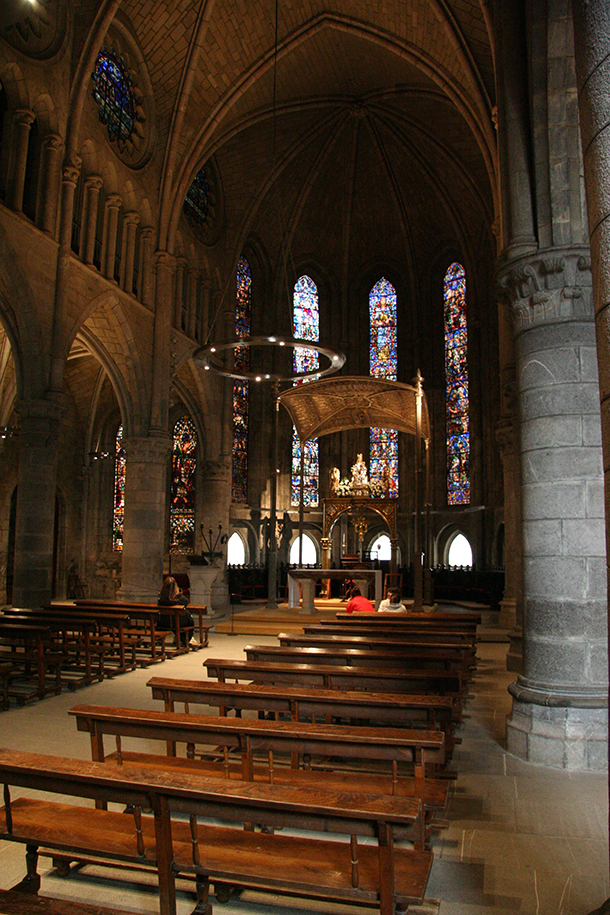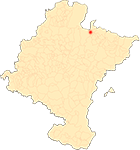Roncesvalles
By Javier Martínez de Aguirre Aldaz
Church of Santa Maria
The church of Santa María occupies a prominent place in the history of Spanish medieval art because of its direct link with works derived from Notre Dame de Paris. Both the original plan and elevation show that the project was designed and executed by an architect of B experience, trained in the architectural internship of the 1200s in Île-de-France. A 13th century poem attributes the church to King Sancho VII the Strong. Its construction would have taken place mainly in the time of the prior Martin Guerra (1203-1216).
The plan outlines a perfectly proportioned rectangle based on squares, articulated into three naves, from which the five-sided chevet stands out, a direct transfer of part of the plan of the Parisian cathedral, as Torres Balbás rightly pointed out. Arches on rigged columns, alternating thick and thin, separate the naves. Above the arches we see a triforium made up of four arches and above them rosettes with pointed arches in borders that directly illuminate the interior of the main nave, as is still the case today in the churches in the Parisian area. Two sections of sexpartite vaults and one with eight ribs that converge at the core topic above the apse mouth cover the main nave. The core topic above the main chapel shows the Coronation of the Virgin, with an angel leaning out from the outside of the circular framework . The perimeter walls are extremely thick. The northern wall houses staircases that go down to the crypt on one side and up to the roofs of the north aisle on the other. The tower was probably added to the first section at the foot of the gospel nave in the 15th century.
The church has been greatly altered to the present day, especially due to the intense reconstruction carried out between 1939 and 1944 by Onofre Larumbe and the architect Francisco Garraus. It was their intention to free it from the remodelling undertaken by Jerónimo de Buega in the 17th century, which concealed its medieval elements. The façade was particularly affected, with a completely new façade, windows and rose window.
Dectot, X., "Yacente de Sancho VII el Fuerte", in Bango Torviso, I.G. (dir. cient.), Sancho el Mayor y sus herederos. El linaje que europeizó los reinos hispanos, Pamplona, 2006, pp. 371-373.
Fernández-Ladreda, C., Imaginería medieval mariana en Navarra, Pamplona, 1989.
Fernández-Ladreda, C. (Dir.), Martínez Álava, C., Martínez de Aguirre, J. and Lacarra Ducay, M.C., El arte gótico en Navarra, Pamplona, 2015.
Fuentes y Ponte, J., report histórica y descriptiva del santuario de Nuestra Señora de Roncesvalles, Lérida, 1880.
García Gainza, M.C., Orbe Sivatte, M. and Domeño Martínez de Morentin, A., Catalog Monumental de Navarra IV**. Merindad de Sangüesa, Pamplona, 1992.
Ibarra, J., History of Roncesvalles. Art. History. Legend, Pamplona, 1936.
Lambert, E. Roncevaux", Bulletin Hispanique, XXXVII (1935), pp. 417-436.
Martínez de Aguirre, J. (coord.), Enciclopedia del Románico en Navarra, Aguilar de Campoo, 2008, vol. III, pp. 1216-1224.
Martínez de Aguirre, J., Gil Cornet, L. and Orbe Sivatte, M., Roncesvalles. Hospital and sanctuary on the Camino de Santiago, Pamplona, 2012.
Miranda García, F. and Ramírez Vaquero, E., Roncesvalles, Pamplona, 1999.
Peris, A., "El Ritmo de Roncesvalles: estudio y edición", Cuadernos de Filología Clásica. Latin Studies, 11 (1996), pp. 171-209.
Pons Sorolla, F., "project de obras de restauración en la capilla del Sancti Spiritus de la Real Colegiata de Roncesvalles (Navarra)", Príncipe de Viana, XXXIX (1978), pp. 59-77.
Soria i Puig, A., The Road to Santiago. II. Stations and signs, Madrid, 1992.
Torres Balbás, L. La iglesia de la hospedería de Roncesvalles", Príncipe de Viana, VI (1945), pp. 371-403.
Thuile, J., L'Orfèvrerie en Languedoc du XIIe au XVIIIe siècle. Généralité de Montpellier, Montpellier, 1966.












